Water management is a constant topic for gardeners and even more so in Mediterranean regions where rainfall may be scarce and/or erratic and water usage heavily restricted.
This year, after two years of drought, we have had a relatively wet and cool spring. Between the beginning of October and until the 6th of July we’ve had about 380mm = 380l per square meter. That’s fantastic and has provided all the new shrubs and trees with a good start. But it’s still not sufficient to really fill up the subterranean resources and our river basin seems to be particularly prone to drought. So we’re back under restrictions and can only water the vegetable gardens before 8am and after 8pm. Newly planted shrubs and trees within the first three years may be watered judiciously but proof of purchase must be shown if and when an inspection by the water police is made.
So it’s well worth researching and testing one’s water-management strategies and tactics. Here are mine:
Choosing Drought-Resistant Plants
It makes no sense to me to try and establish plants from cooler, wetter regions in a Mediterranean garden. Depending on altitude and/or local microclimate, plants like Hydrangeas, Acer palmatum and the like may be able to flourish in a some shady garden but even then they will need constant watering in summer and to me that’s just not worth the effort.
I choose plants for Mediterranean climates and I’ve learned to factor in altitude. A garden at several hundred meters altitude works differently from my inland garden at almost sea level – even though they may be a mere 40km apart in the same Mediterranean region. The former may see a lot more success with plants for “mountain” or “continental” climates, plants that like cooler nights and colder winters (i.e. currants, gooseberries, raspberries, etc.). In my garden I’ve learned the hard way to stay away from such plants or from plants suited to milder “oceanic” climates.
I check plants purported to tolerate drought on Wikipedia to see where they naturally flourish. And I use sources like Olivier Filippi’s www.jardin-sec.com in Mèze with its very practical “codes de secheresse”.
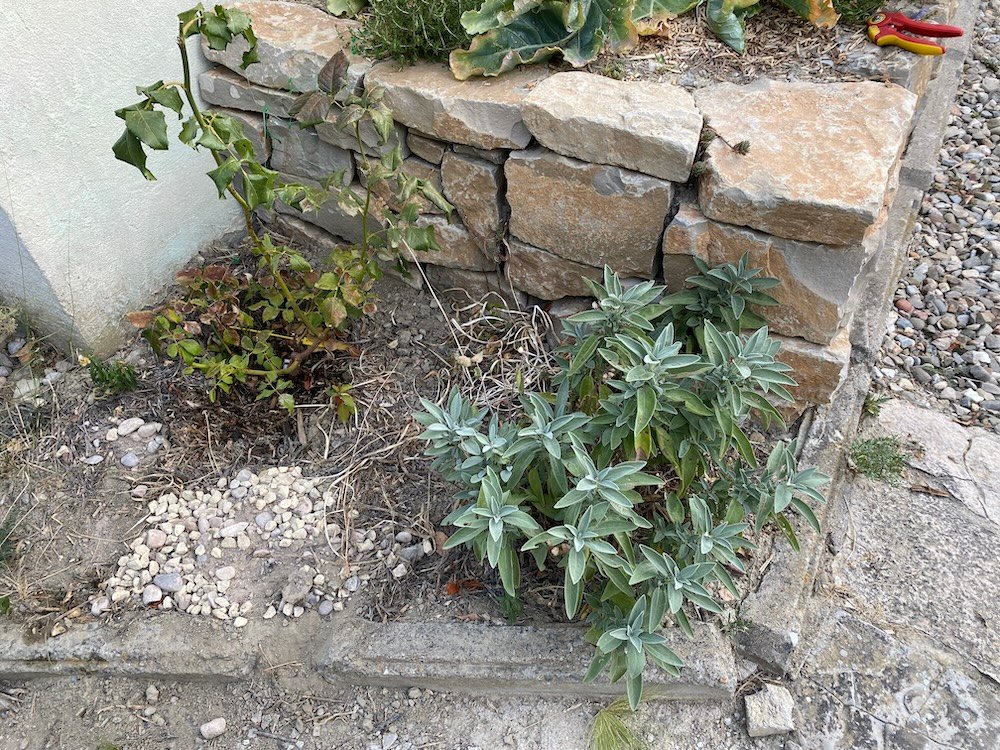
Drought-Resistant Planting
In drought-resistant planting the evaporation of water from the soil and if possible from the plants themselves must be minimized. To this end the soil should be heavily mulched with organic material like wood/bark chips in the ornamental garden or hay/straw* in the vegetable garden. We’ve bought a shredder to make good use of all the prunings and trimmings throughout the year. And I’m always on the lookout for sales and cheap chips. Ground-covering plants are another way to keep the soil covered in the ornamental garden.
Plants should be planted as close as possible to shade each other and the soil. I’ve learned that traditional plant spacing rules can be ignored – at least in the vegetable garden. In the ornamental garden trees and large shrubs will provide natural shade during the hottest months. My raised vegetable beds are shaded with home-made canopies, which also minimize wind evaporation. I also try to make the soil more water-retentive by adding zeolite granules to the soil when planting.
Note: these tactics for planting obviously do not apply to Mediterranean gravel gardens, where the soil is “mulched” via a deep cover of gravel over fabric.
(* I prefer hay or mulching material like miscanthus etc.. Straw tends to use up utrients like nitrogen from the soil as it rots)
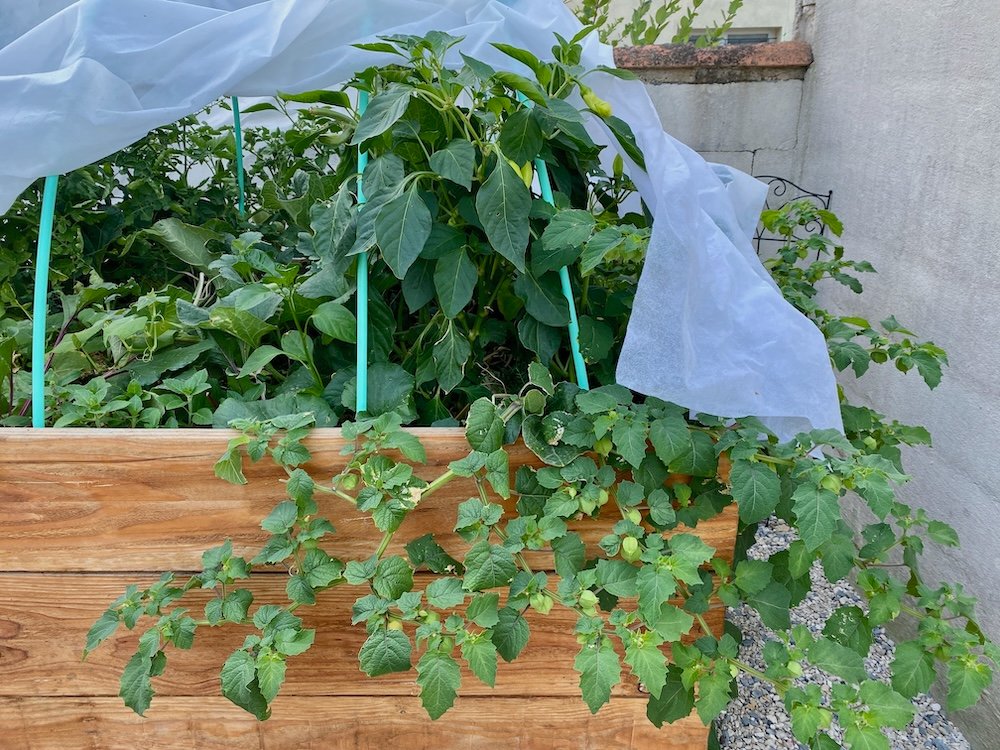
Drought-Resistant Soil
The “natural” soil in this garden is poor, chalky, soft as dust on top, and hard as rock a spade or two down. It clogs up quickly in heavy rainfalls with the water puddling and taking quite some time to penetrate into the bottom layer. But it also quickly dries out again.
This type of soil needs to be improved over time by adding organic material as mulch or to be replaced with quality soil. In the vegetable beds we mixed the existing soil with equal amounts of compost and guano and the plants are really thriving this year. The zeolite added in planting also helps to retain nutrients close to the roots. In the rest of the garden we go for organic improvement by constantly adding mulch in the form of wood chips or green stuff.
Note: The quality of the soil should be improved but it should not become too water-retentive. Most drought- and heat-resistant Mediterranean plants hate “wet feet” and need very good drainage, especially during the more humid winter months. To ensure drainage I make a large planting hole and add rough gravel and coarse building sand when setting this type of plant.
Watering Methods
During the height of the summer season and the regularly occuring heatwaves, watering can only have the effect of helping those plants that need it, to stay alive and make it through the summer. No watering method can have the visibly refreshing effect of a good several hours or a day or two of rain. Real rain is something no gardener can recreate with reasonable means – especially in regions with water restrictions in place.
Sprinkler irrigation may seem to emulate rain, but in this region it is the least efficient and the most dangerous method of watering a garden – especially in the heat of summer. It is inefficient and wasteful because the water does not go directly to plants’ roots but is spread over a wide area, dampening the soil even in places where no water is needed. And it is dangerous because dampening plants’ leaves in summer can open doors for all kinds of mildew and fungal diseases (especially with cucumbers, tomates, roses etc.).
The best method of watering remains invisible. It does not show itself in damp soil or wet leaves, however much this would sometimes delight my thirsty gardener’s heart. It goes as directly as possible into the soil and to the plant’s roots – ideally over a period of several hours in the case of trees or large shrubs.
Drip Irrigation
Drip irrigation or soaker hoses are very popular here. Water is slowly released either drop by drop or by seeping into the ground as closely as possible to the plants over an adequate period of time.
Watering Hoses or Cans
My raised vegetable beds make drip lines or soaker hoses impractical. I manage by mulching, by planting closely, and by shading. During the height of summer I water the plants twice a week by hand, with a hose or watering can directly at the root (when planting I form a bowl of soil around each plant, so the water does not run off). So far these tactics have proven to be quite sufficient. Even during heatwaves with 35+ degrees all plants are thriving and fruiting.
Cuvettes and Tree Bags
When planting, all trees and shrubs get cuvettes: deep and wide watering “bowls” around the trunk. They are then heavily mulched and get a deep watering every 2-3 weeks during the first summer, depending on rainfall. The cuvettes can be watered by watering can or ideally with the garden hose set to a light drip over several hours. I usually time the drip by filling a watering can first so I have an idea of how much water the tree is getting. For new trees I have also used tree bags or tree rings (i.e. from Baumbad) that release a set amount of water over 8-12 hours.
As trees widen their crowns, their roots will spread out underground as well. This means that watering into the original cuvette right next to the trunk may not be sufficient anymore. If a tree shows signs of distress despite a good watering into the cuvette, I widen it or make a shallow trench farther out and water into this trench as well. During the second summer drought-resistant trees should get by with 2-3 deep waterings, depending on heat/rainfall.
I also keep a record of how much water the bigger plantings are getting.
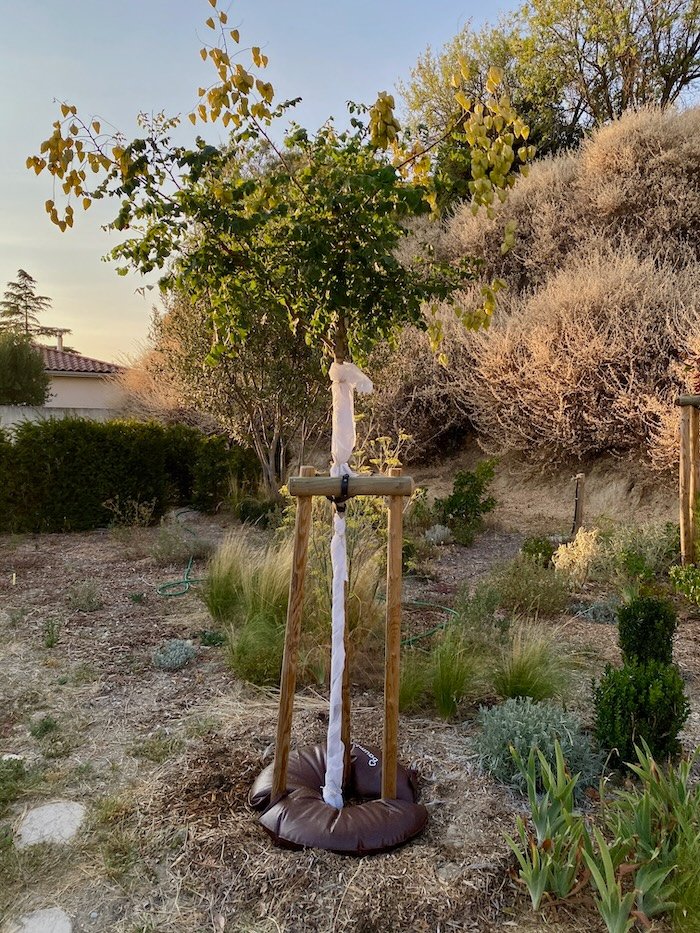
Watering Times
Whatever the method, it is best to water very early in the morning or during/after sundown to minimize evaporation. I prefer the evening because the water will help the plants restore themselves after a long day in the hot sun. But if it’s still above 30 degrees in the evening, I water at first light in the morning.
Watering Frequency
A plant that needs to be watered daily has no place in this region. It is generally not a good idea to water daily. Instead, deep watering at regular intervals will encourage plants to grow roots to access water at deeper levels.
Saving Household Waste Water
It would seem impractical and superfluous to have potted plants on the terrace when you have such a large garden. However our large terrace would have all the charm of an empty gym hall without some green plants along the walls. For potted plants we save waste water in the kitchen (i.e. water from washing vegetables, boiling eggs, rinsing out teapots etc.) and bathroom (i.e. water from washing hands or water from waiting for hot shower water etc.). Saved waste water can of course also be used in the garden or to keep the compost from drying out.
Rainwater recuperation
This summer we got our roof gutters replaced and we had two water recuperators installed with a volume of 1000l each, one for each side of the roof. We have a pretty large roof and they filled up in only 2-3 hours of hard rain! We may never need water from the tap or forage again – finally completely worry-free watering!
And What About Rain?
It does rain here. Mostly between October and May and sometimes it even rains a lot. So does one need to water when it’s just rained? It depends. A nice little summer rain of about 2mm will make the garden look fresh and wet but if you use a hand trowel you’ll see that barely 1cm of the top soil layer has been moistened and that the rest is still dry as dust. So not much use to most plants besides a little refreshment for the foliage. In the winter 2mm of rainfall may have a bit more effect and then it may not be advisable to water additionally – except for young plantings.
How to tell how much rain has fallen? Subjective impressions of length, intensity and quantity of rainfall can be very deceptive. I’ve bought a simple rain gauge (“pluviomètre”) to show exactly how much rain has fallen and if there is a need to water additionally or not. Anything over 10mm (= 10 liters per square meter) is probably enough for a day or even several days, depending on the season.
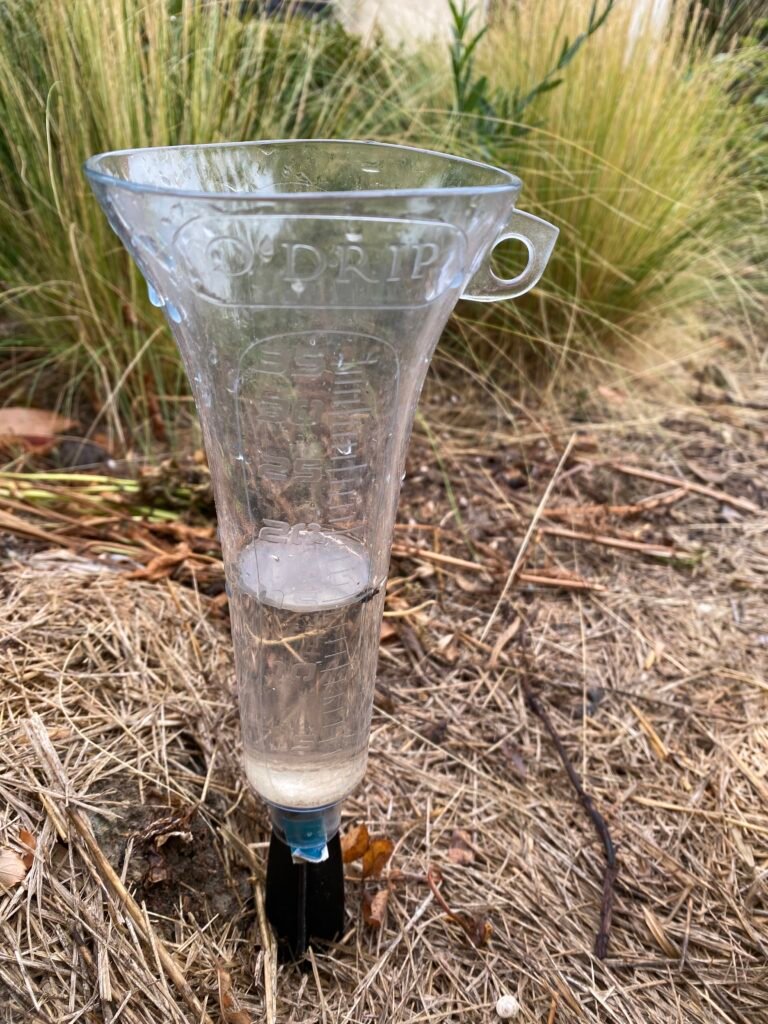
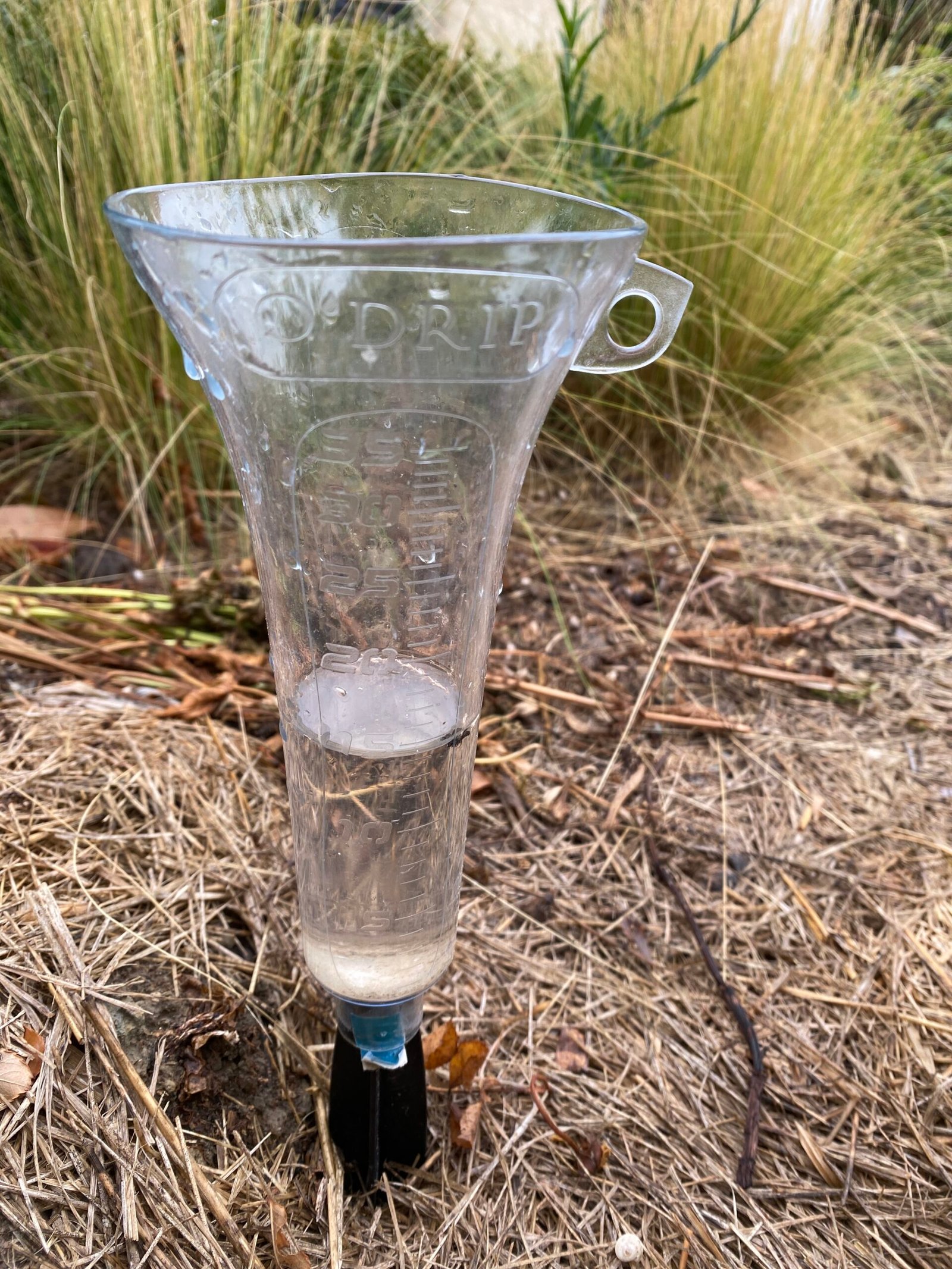
Leave a Reply